Speaks for itself really .......
37 Terrifying Amusement Park Rides That Remind Us of Our Childhood Summers
Look back at the best, worst, and most hair-raising amusement park rides through the years.

The National Amusement Park Historical Association notes that "pleasure gardens" — places devoted to outdoor entertainment — have been offering thrills to summertime visitors since way back in the 1550s. While rides back then were more primitive, attractions that we'd know and recognize today, like carousels and roller coasters, started popping up by the early 1800s. And even starting way back then, the race was on, with amusement parks competing for faster, higher, and more pulse-pounding attractions. Some of these led to rides that are still around today, in some form or another, like looping coasters or extra-tall Ferris wheels. Others provided heart-racing experiences during the mid-century heyday of local funfairs, but were lost when smaller, local parks gave way to modern development in the '60s and '70s. And still others, well, they were a bad idea to begin with, and are probably best left to the annals of history. We took a look back at amusement parks through the years, and couldn't believe these rides were ever built, either because they're too pulse-pounding — like today's highest, fastest, and steepest roller coasters — or because they seem like they'd be too stomach-churning to ever ride, even for a wild summer break with friends.

1846: Centrifugal Railway, Manchester, England
Looping "roller coasters" have been in existence for longer than you'd expect; they were exhibited in the United Kingdom as early as 1843, and the first permanent "centrifugal railway" planted roots in La Havre, France shortly after. The problem with these rides is that the loops were too circular, which subjected riders to uncomfortable amounts of G-force.

1897: The Steeplechase, Brooklyn, New York
Brooklyn's Coney Island has been home to many iconic amusement parks over the years, and has been the site of numerous boundary-pushing rides. The Steeplechase, the centerpiece of Steeplechase Park, is just one example: It featured side-by-side, gravity-powered wooden horses that "raced" each other down a 1,000-foot-long track. While Steeplechase Park was demolished in 1966 (by Fred Trump!), the amusement park that's in operation on Coney Island now, Luna Park, features a Steeplechase-themed roller coaster as a nod to the area's history.

1893: The Original Ferris Wheel, Columbian Exposition, Chicago, Illinois
Also called the Chicago Wheel, this Ferris Wheel was the main attraction at the 1893 World' Fair. It reached a height of 264 feet, and was so solid that when tornado-force winds hit the wheel with their full might, the wheel was unharmed. After the Exhibition, the wheel was dismantled and shipped to St. Louis for the 1904 World's Fair.

1895: Flip-Flap Railway, Sea Lion Park, Brooklyn, New York
Also in the Coney Island area of Brooklyn, the Flip-Flap Railway was the first looping roller coaster in the United States. It also had a circular track, and actually gave some unlucky riders mild whiplash. But it could have been worse: Around the time the Flip-Flap Railway was decommissioned, the parks were testing a "Cannon Coaster," which had cars that were meant to jump a gap in the tracks. It was deemed unsafe during testing and never debuted for riders.

1903: Loop the Loop, Luna Park, Brooklyn, New York
Instead of the Cannon Coaster, Luna Park came back with a Loop the Loop, which had a more oval, more comfortable inversion for riders. Still, since you could fit so few riders on the track at a time, it was hard for ride operators to make a profit on this one.
RELATED: 40 Iconic Stores You Grew up With That Are No Longer in Business

1908: Flip-Flap Ride, Franco-British Exhibition, White City, London
London's Flip Flap was not a roller coaster — it was a viewing platform that could hold 50 people, then lift them 200 feet into the air. That gave them a view of the grounds of the Franco-British Exhibition, where it was housed.

1908: Devil's Wheel, Oktoberfest, Munich, Germany
Devil's Wheel rides have been used at Oktoberfest since the early 1900s, and the premise is simple: Riders sit in the middle of a revolving platform, which spins faster and faster until the riders are flung off to the side. (At an Oktoberfest? Where people have been drinking? No thank you.)
RELATED: Things That Happened the Year You Were Born That You Probably Didn't Know About

1908: The Tickler, Chester Park, Cincinnati, Ohio
The Tickler ride sends cards twisting and turning down a curved path. The sign hanging on the entrance fence for this one says it all: "Remodeled: Not as rough as last season."

1910: The Human Pool Table, Steeplechase Park, Brooklyn, New York
Steeplechase Park's Pavilion of Fun had many swirling rides for those with strong stomachs. The Human Roulette Wheel operated much like a Devil's Wheel, while the Human Pool Table (pictured here) challenged visitors to slide from one end of the room to another without getting thrown around by spinning platforms on the floor.
RELATED: Here's What School Looked Like the Year You Were Born

1920: Wonder Wheel, Coney Island, New York
Coney Island's famed Wonder Wheel is celebrating its 100th anniversary in 2020. While it's not the oldest ferris wheel still in operation today — that's the Weiner Riesenrad in Vienna, Austria — the Wonder Wheel distinguishes itself by having an inner ring of cars that roll back and forth as the wheel revolves.

1923: Bumper Cars, Glen Echo Park, Glen Echo, Maryland
Bumper cars are an amusement-park staple, but take a look at how far they've come. These bumper cars at Glen Echo Park look un-padded, un-protected, and very, very full. Makes you feel like today's dodgems are a little too cushy (although they probably go much faster).

1927: Racer, Kennywood, West Mifflin, Pennsylvania
Kennywood's historic Racer does a neat trick: Two trains start off at the same time, and, when they return, they've switched platform sides (without somehow colliding mid-course, and staying neck-and-neck throughout). How? The trains are actually on one, continuous track — called a möbius loop roller coaster — and it's the only one in the United States still in use today.

1927: Derby Racer, Playland, Rye, New York
Similar to the Steeplechase, the Derby Racer at Playland in Rye, New York lets riders feel like they're really in a horse race. The horses whip around in a circle at a speed of 25 mph, and, to compensate for the centrifugal force, riders actually have to put all their weight on one foot to keep from being thrown off. The Derby Racer was damaged in a fire in 2017, but plans are in the works to refurbish and reopen the attraction.

1930s: Auto Race, Kennywood, West Mifflin, Pennsylvania
Kids can get a taste of what it's like to hit the road at the Auto Race ride, which puts riders in the driver's seat and lets them go. While this type of ride was popular in the 1930s, Kennywood has the only surviving one today.

1930s: Auto Race, Kennywood, West Mifflin, Pennsylvania
Originally, the Auto Race cars were modeled to look like Packards. In the '40s, hills were removed from the tracks because, on drizzly days, the cars couldn't always make it over the hills. The windshields and headlights were also removed from the cars early on, which gives them a sportier look.

1930: Helter Skelter, Gorky Central Park of Culture and Leisure, Moscow, Russia
If you couldn't' already glean it from the Beatles song, a helter skelter is a type of twisty slide that typically winds its way around a tower, and they've been in use at fairs since the early 1900s. But this on in Moscow's Gorky Park, designed to look like the Tower of Babel, features an extra-tall tower, which makes for many twists and turns.

1930s: Loop-O-Plane, Kennywood, West Mifflin, Pennsylvania
Called "The Salt and Pepper Shakers" by those in the know, the Loop-O-Plane is just what it sounds like: Mechanical arms take riders, over and over, in a stomach flip-flopping, upside-down-turning loop. This ride was eventually removed to make way for more modern iterations.

1941: Parachute Jump, Coney Island, New York
Originally built for the 1939 World's Fair, the Parachute Jump eventually made its way to Steeplechase Park in 1941. Riders were strapped into a chair, lifted by cables high into the air (the tower is 200 feet tall), then dropped. Though the parachute and cables slowed riders down, the descent was still a fast one (15 seconds or so), it was more akin to free-fall.

1941: Parachute Jump, Coney Island, New York
If you could stomach the heights and the speed, the attraction gave riders a great view of the beach and park. Though the parachutes are no longer in operation, the Parachute Jump tower is a designated landmark.

1949: The Looper, Rockaways' Playland, Rockaway Beach, New York
This ride may look like a guaranteed stomachache, but riders were actually in control of how many loops they did, so the level of thrill was up to them. This version of the Looper is from Rockways' Playland, which closed in 1987, but you can still find one in operation at Knoebels in Elysburg, PA.
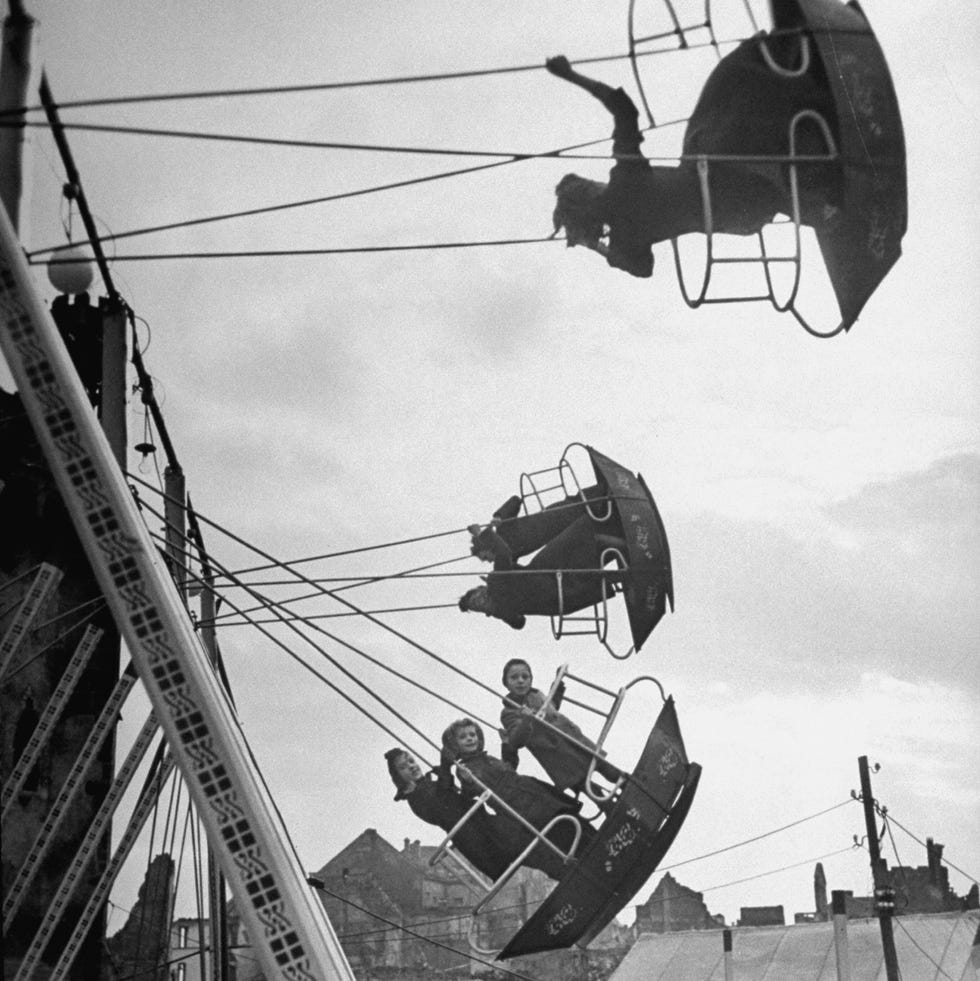
1949: Stand-Up Swing, Park Unknown
The location of this photo is unknown, but you can see that this swing ride does not require riders to sit down — you just stand up and hold on for dear life.
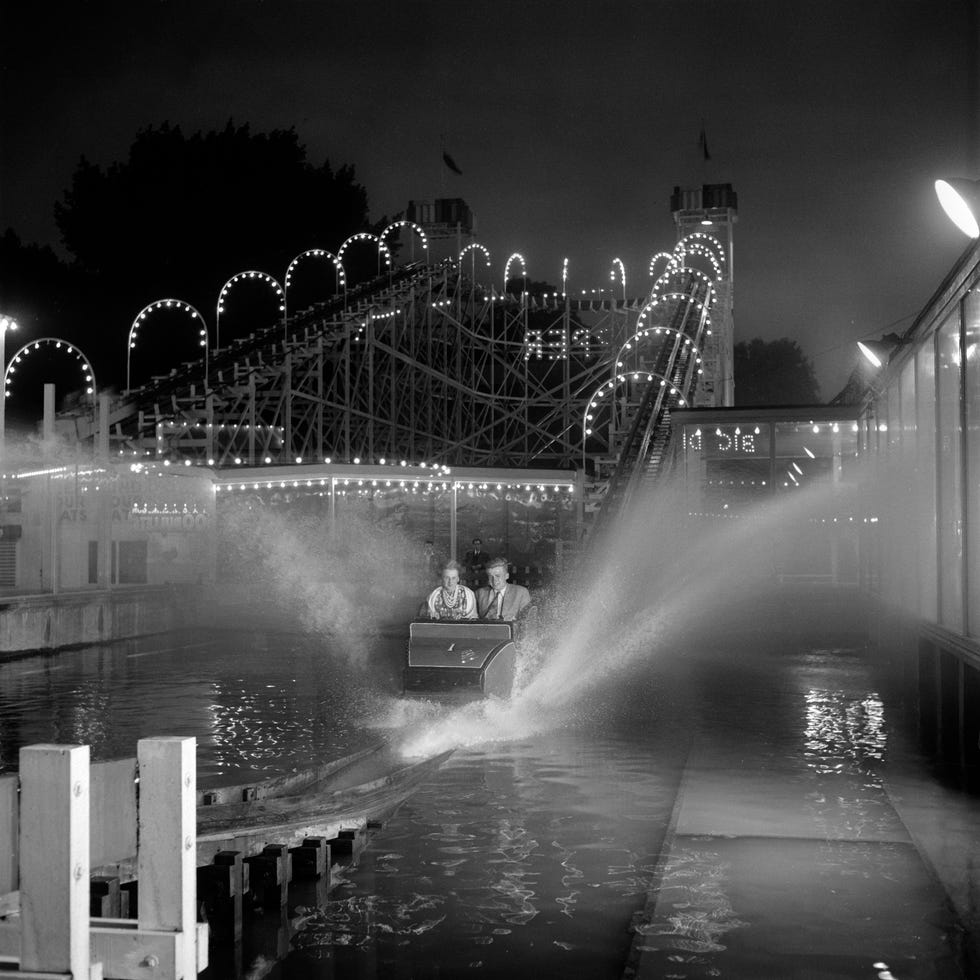
1951: Big Dipper, Festival of Britain Pleasure Gardens, Battersea, England
The Big Dipper was the main attraction at the Festival of Britain Pleasure Gardens, drawing famous riders from the Duchess of Kent to members of the Bolshoi Ballet. The coaster wasn't too tall — it only reached a height of about 50 feet — but it rocketed down its hill with a satisfying splash at the bottom. The ride remain in operation until the '70s, when, sadly, it was involved in a major accident that killed five people.
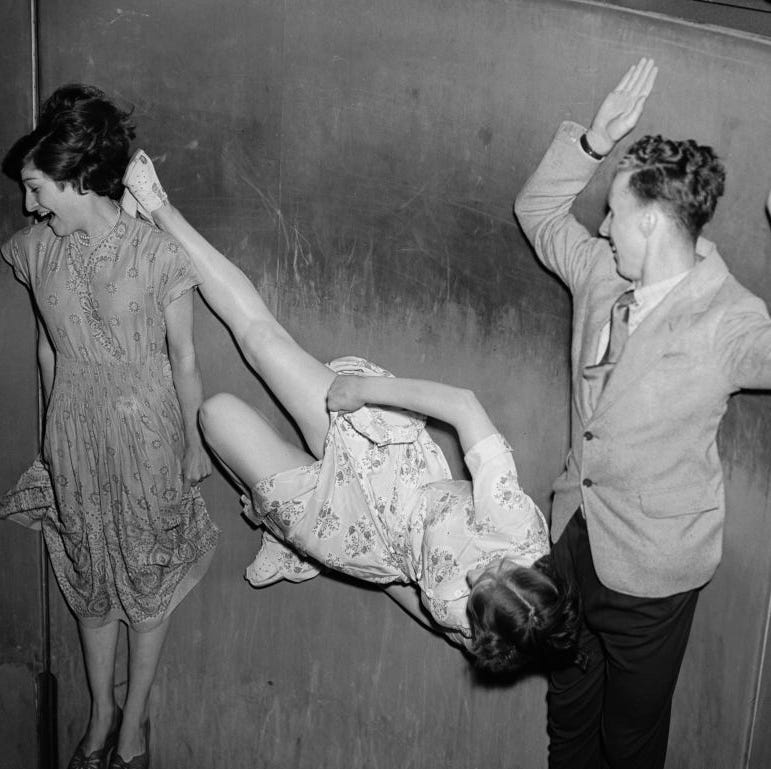
1951: The Rotor, Festival of Britain Pleasure Gardens, Battersea, England
Also a feature of the Festival of Britain Pleasure Garden, The Rotor spun riders until the centrifugal force pinned them to the walls. You can find this type of ride at many parks today, though it's probably harder to do a full-horizontal the way this rider is attempting.
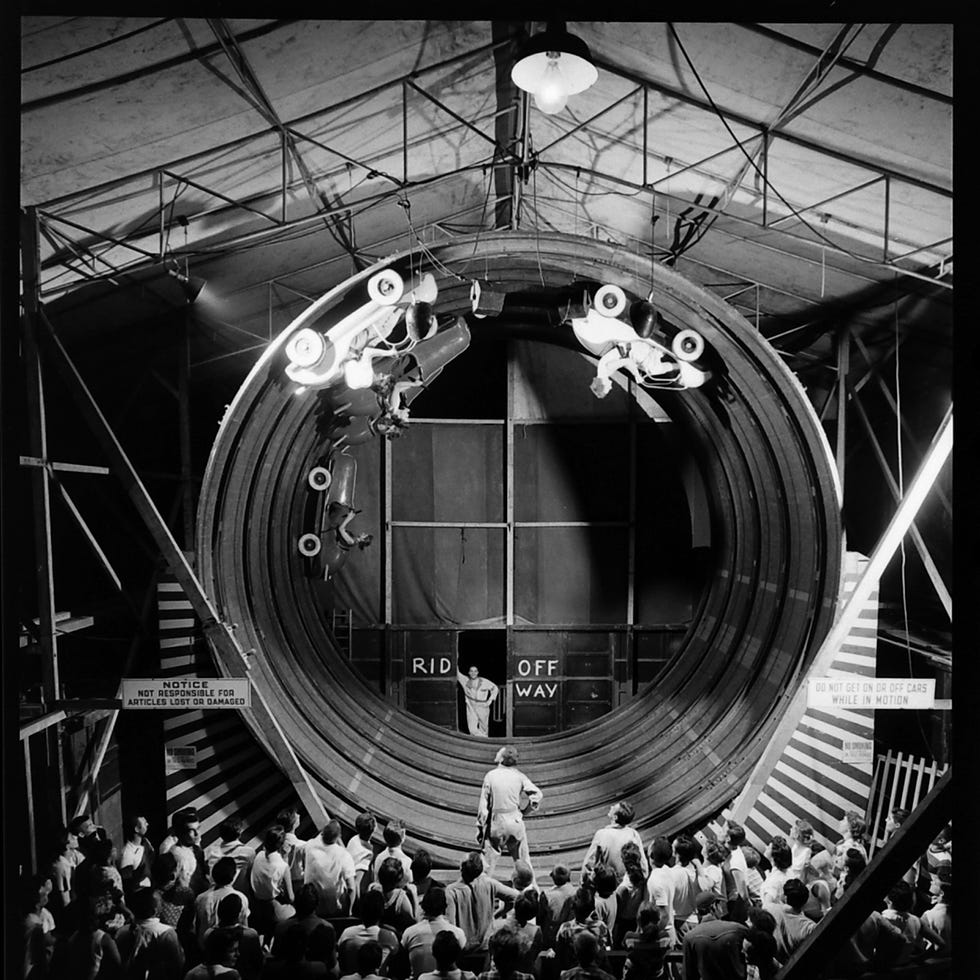
1954: Flying Cars, Riverview Park, Chicago, Illinois
You can see video of this ride in action: Not only did the cars roll around inside the looping track, the entire drum rotated in a circle, sending riders on a 30 mph spin.
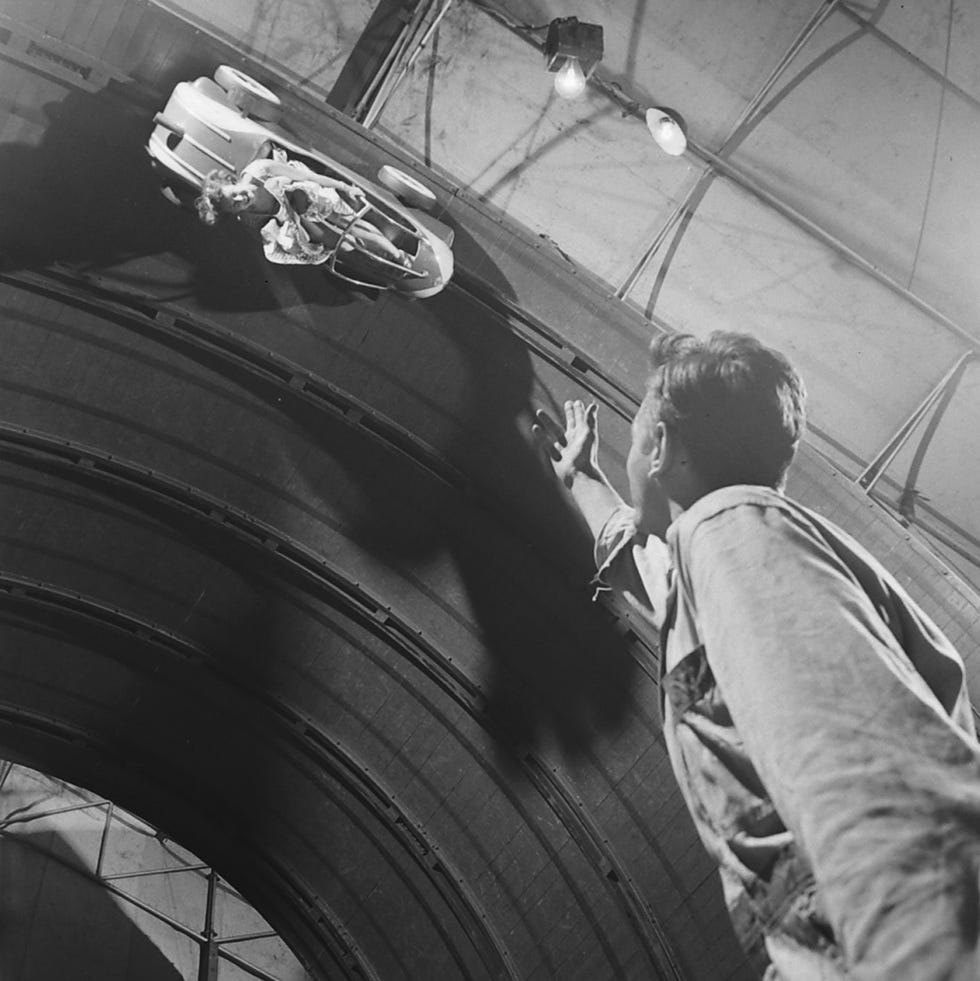
1954: Flying Cars, Riverview Park, Chicago, Illinois
Spectators could watch from down below — perhaps a bit too closely — at Riverview Park in Chicago. The attraction shut down in the mid-'60s due to safety concerns, and Riverview closed entirely in 1967.
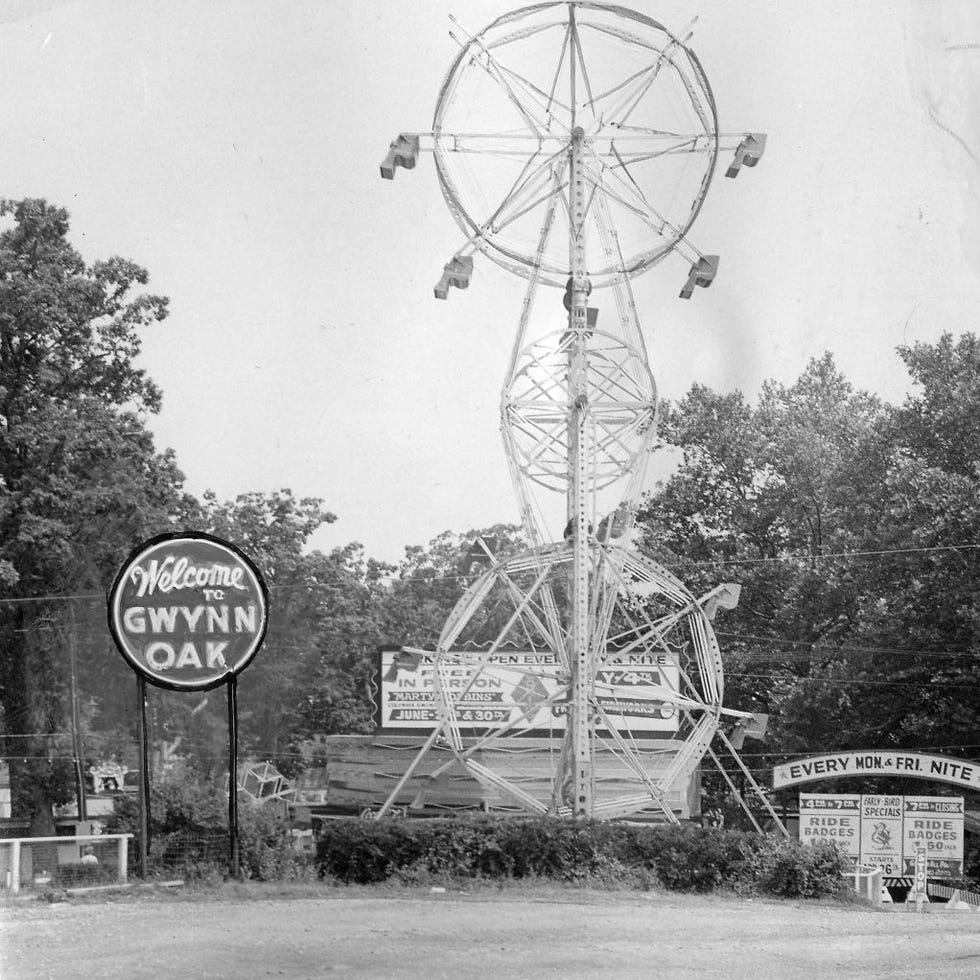
1963: Double Ferris Wheel, Gwynn Oak, Gwynn Oak, Maryland
When one type of rotation isn't enough, enter the double Ferris wheel: Two riding wheels are connected by a mechanical arm that also rotates for an extra layer of spin. This one is from Gywnn Oak, which, before it closed in 1973, was the inspiration for the "Tilted Acres" theme park in the movie Hairspray.
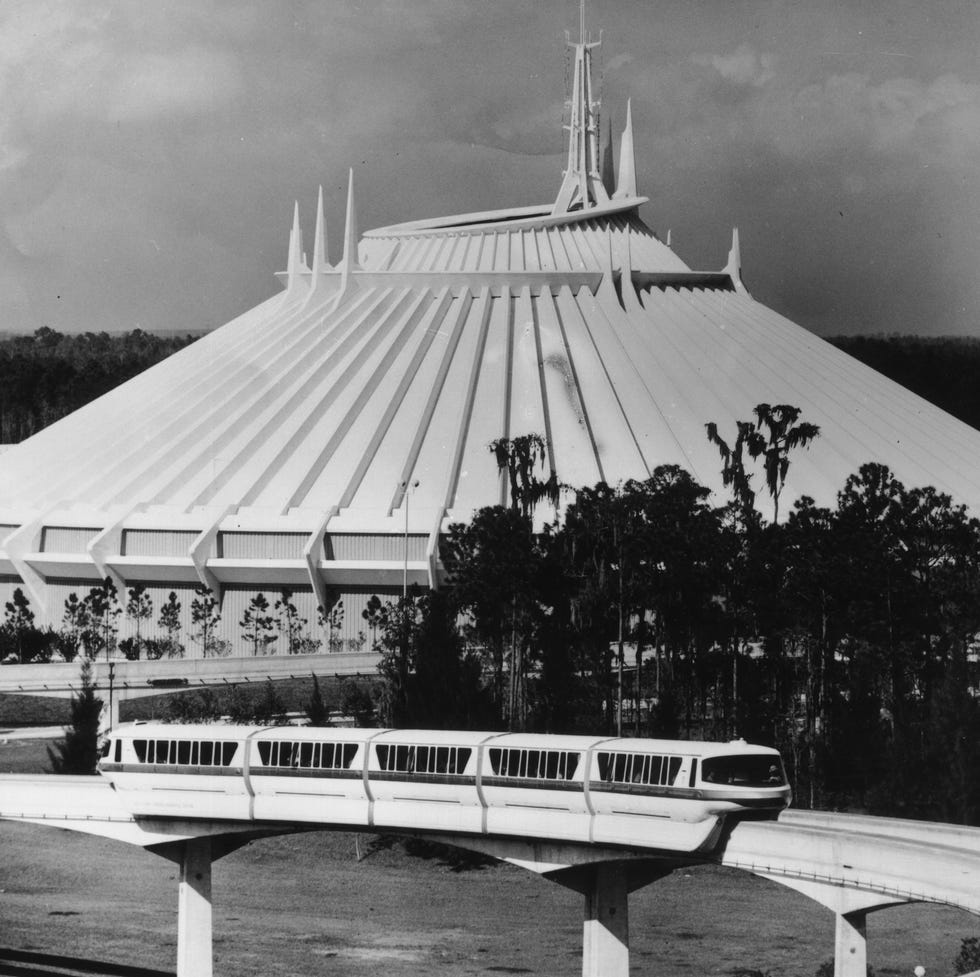
1975: Space Mountain, Walt Disney World Resort, Orlando, Florida
"Dark" rides have existed since the dawn of the amusement park, but they were usually Tunnel of Love-style attractions, or, once in a while, a creepy haunted house. Disney's Space Mountain is reportedly the first indoor roller coaster that was meant to keep riders in darkness so they don't know when the dips in the ride will come up. Leave it to Disney to realize that, in order to be truly thrilling, a ride has to engage the mind over anything else.
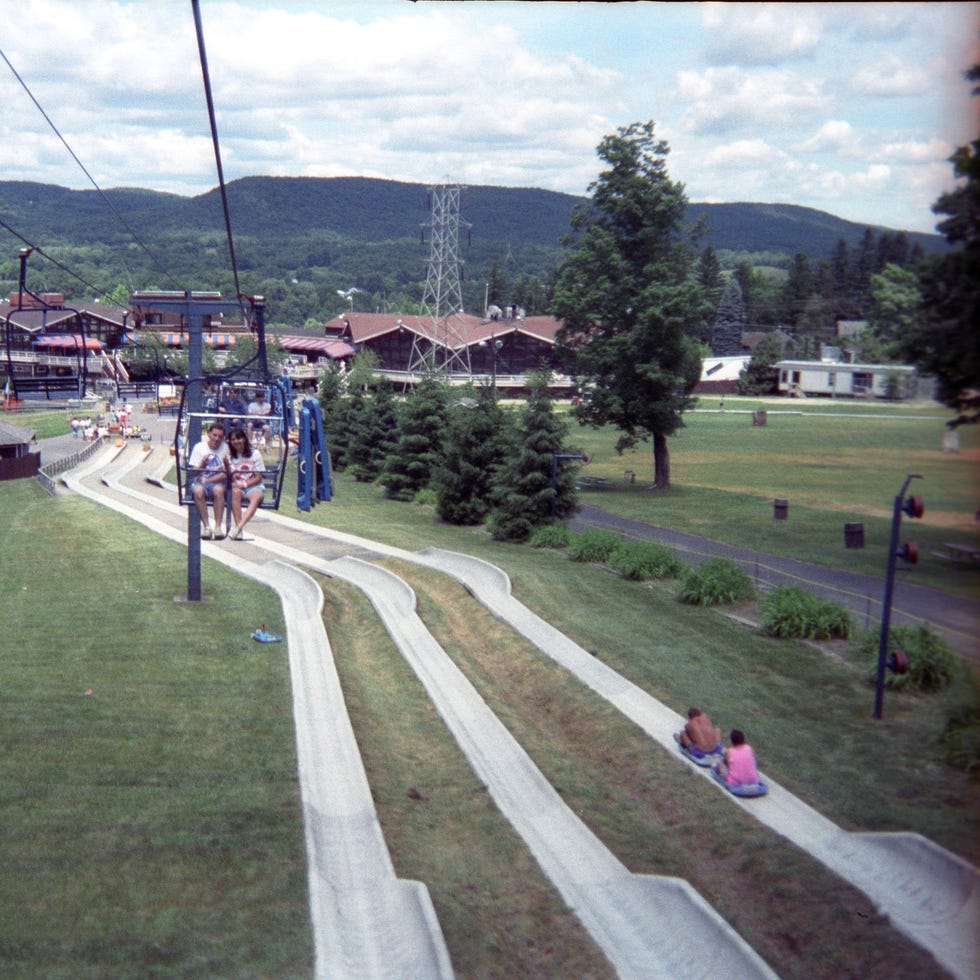
1985: Alpine Slides and Cannonball Loop, Action Park, Vernon, New Jersey
For people who grew up in the New Jersey area in the '80s, Action Park was an infamous theme park full of injury-inducing rides — the park was given nicknames like "Accident Park" or "Class Action Park" (the title of an upcoming documentary about the place). One such attraction was the Alpine Slide — which was described in History by a park-goer as "essentially a giant track to rip people’s skin off that was disguised as a kid’s ride.” But, in a park full of bad ideas, the Cannonball Loop stands out as being particularly misguided: The enclosed waterslide often didn't give riders enough momentum to make it through the inversion, so park operators reportedly had to install a hatch at the bottom for stuck riders to escape through. Though there is video of riders making it through the loop, the slide was shut down very quickly after it debuted in 1985.
![Ron Toomer [Misc.] semi distant photo of cars full of riders starting the 206 foot, 70 mph drop on world's largest roller coaster, the magnum xl 200 designed by ron toomer, shot from the side, at the cedar point amusement park photo by taro yamasakithe life images collection via getty imagesgetty images](https://hips.hearstapps.com/hmg-prod/images/amusement-park-cedar-point-magnum-1589318581.jpg?crop=0.674xw:1.00xh;0.326xw,0&resize=980:*)
1989: Magnum XL-200, Cedar Point, Sandusky, Ohio
From the ground the drop of this Cedar Point standout is almost too much to bear. Indeed, when it opened in 1989, this was the steepest drop in the world. It was also the world's first hypercoaster, meaning the first roller coaster taller than 200 feet, and it held the record for tallest coaster until 1994. You can still ride it today, though the 60-degree angle may seem quaint compared to some more recent thrill rides.

1994: Shockwave, Drayton Manor Theme Park, Staffordshire, England
Stand-up roller coasters were a novelty when they first appeared in the '80s and '90s, but the Shockwave managed to separate itself from the pack by being the only stand-up coaster, ever, to also include a zero-gravity roll, too. Too much? Only you can decide: The ride is still open at Drayton Manor.
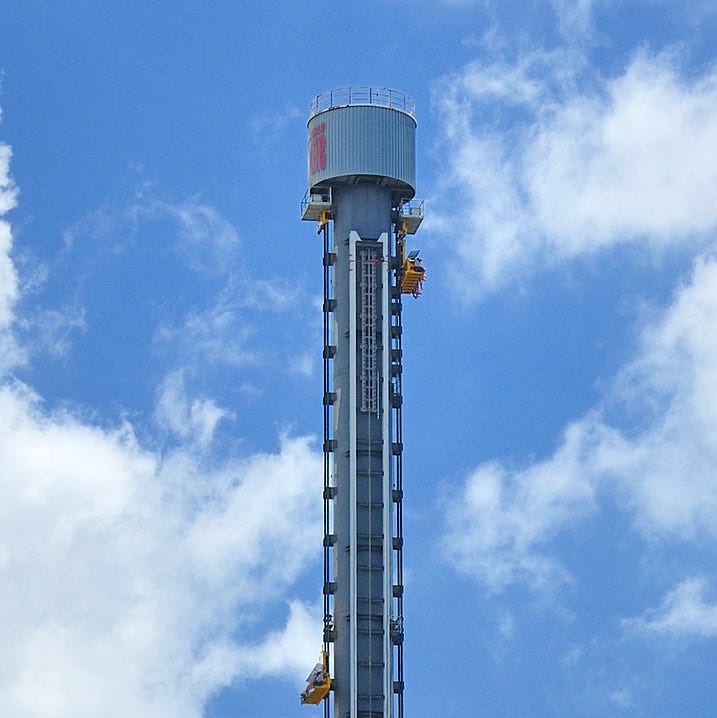
1998: The Giant Drop, Dreamworld, Coomera, Australia
Though ultimately de-throned, this ride had the longest reign as the tallest drop tower in the world — a record it held from 1998 to 2012. (It was beaten by Lex Luthor: Drop of Doom at Six Flags Magic Mountain in California.) Riders drop for a total of 377 feet — screaming the whole way, no doubt.

2003: X-Scream, Stratosphere, Las Vegas, Nevada
This one isn't located at a theme park per se — it dangles from the top of the Stratosphere Hotel in Las Vegas, making it one of the five highest-situated thrill rides in the world. When riders look over the side, they see an 866-foot drop. But is this a gamble you'd want to take?
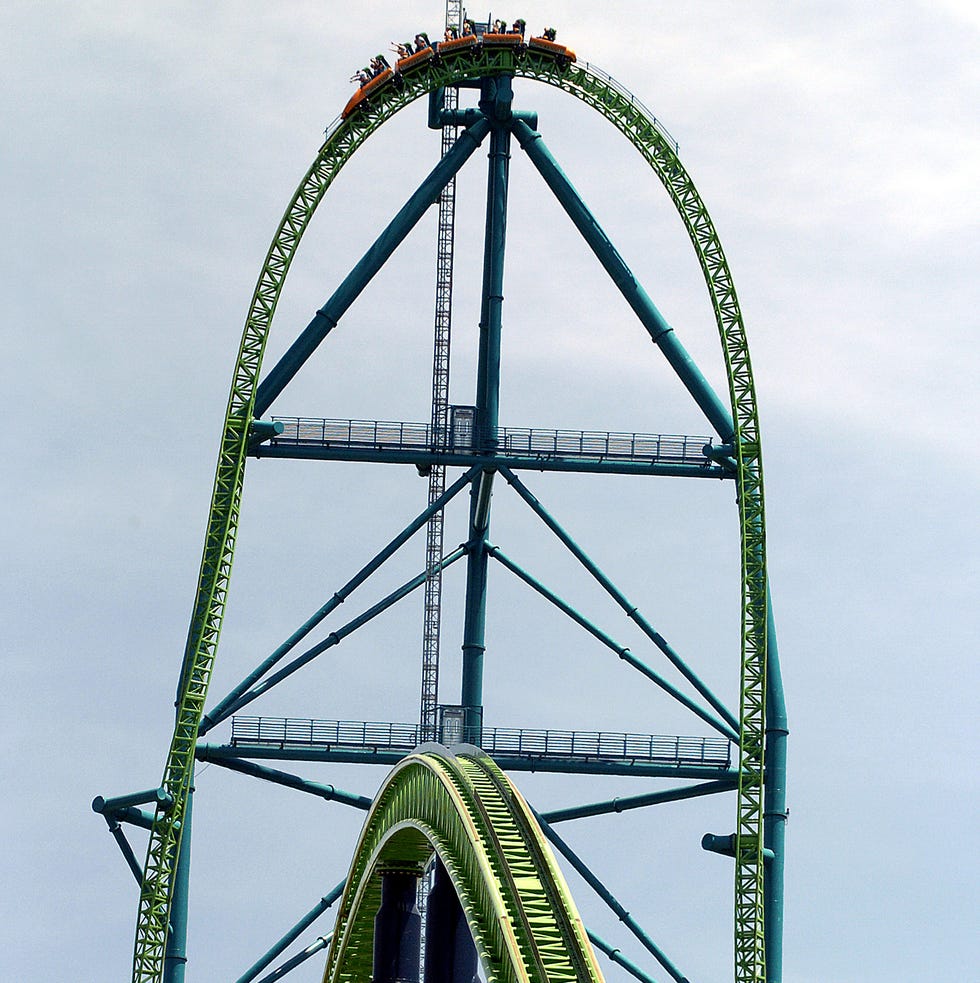
2005: Kingda Ka, Six Flags Great Adventure, Jackson, NJ
Great Adventure's Kingda Ka is a current three-way record-holder: It's the tallest (456 feet), has the biggest drop (418 feet), and the attached Kilimanjaro: Drop of Doom is currently the tallest drop tower in the world. In other words: Nope, nope, and nope.

2006: Steel Dragon 2000, Nagashima Spa Land, Nagoya, Japan
For Nagashima Spa Land's Steel Dragon coaster, you're going to need some stamina: It's the longest roller coaster in the world, with a length of more than 8,133 feet. And yet, it still takes only four minutes to ride (that's 95 mph for those doing the math).
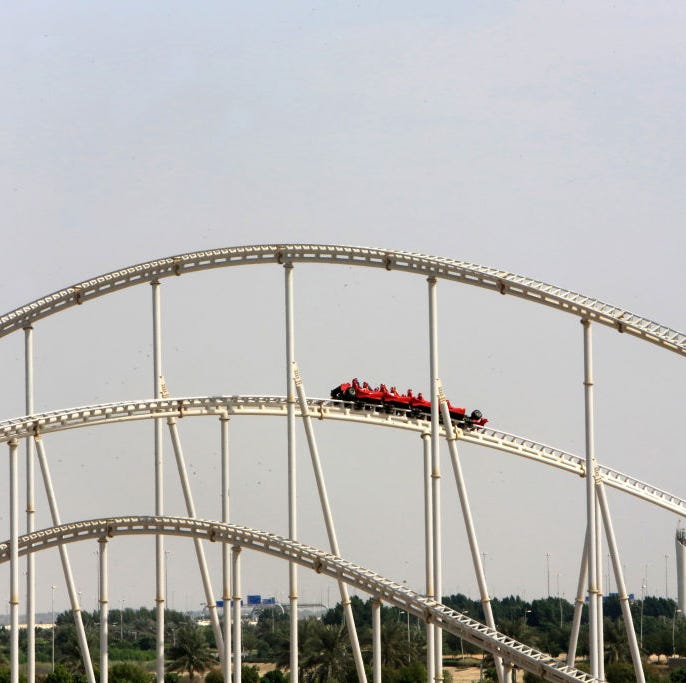
2010: Formula Rossa, Ferrari World, Yas Island, Abu Dhabi
Kingda Ka may be the highest, Steel Dragon 2000 may be the longest, but Formula Rossa is the fastest — it goes a whopping 149 mph. No wonder it's located at a Ferrari-themed amusement park. At speeds that fast, riders are asked to wear protective goggles in case of collision with bugs. (Yuck.)
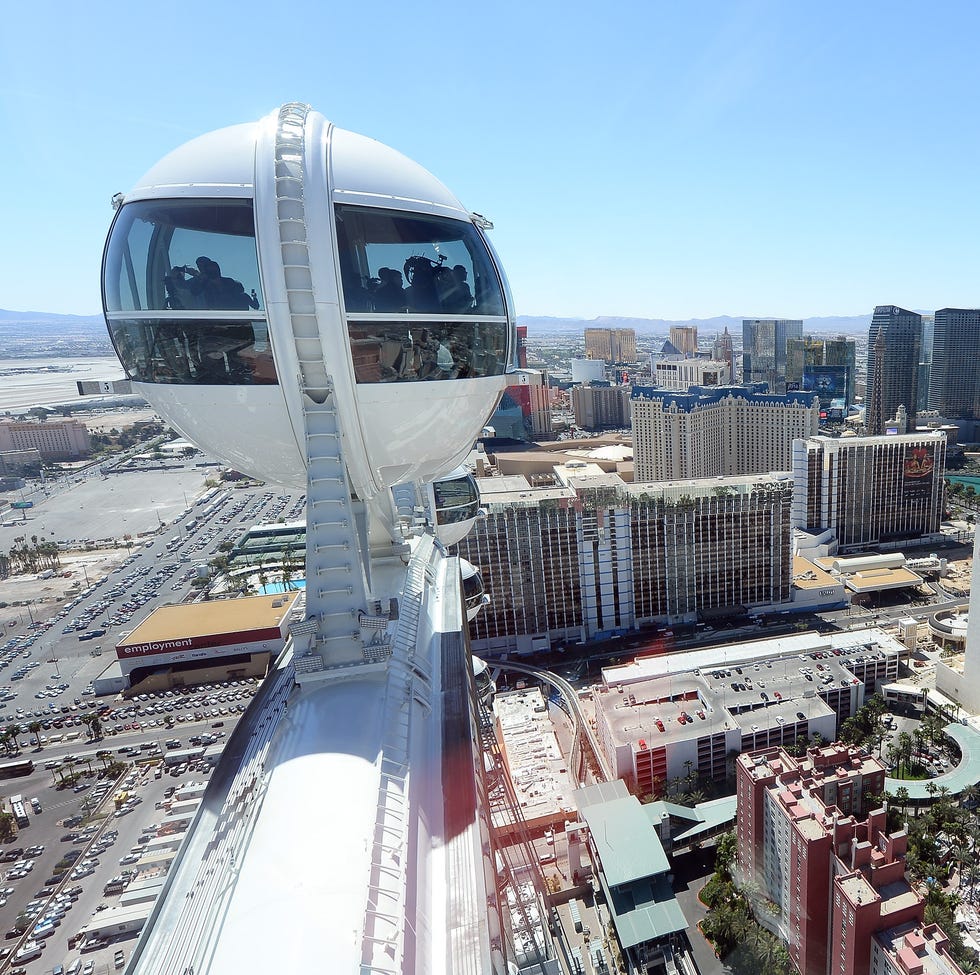
2014: The High Roller Observation Wheel, The LINQ Hotel, Las Vegas, Nevada
Ferris Wheels never hold on to the title of tallest for very long — the record's been broken four times since the year 2000 — but the current champ is at the LINQ in Las Vegas. The High Roller rises to a height of 550 feet — beating its predecessor, the Singapore Flyer, by just nine feet — and takes 30 minutes to do one rotation.
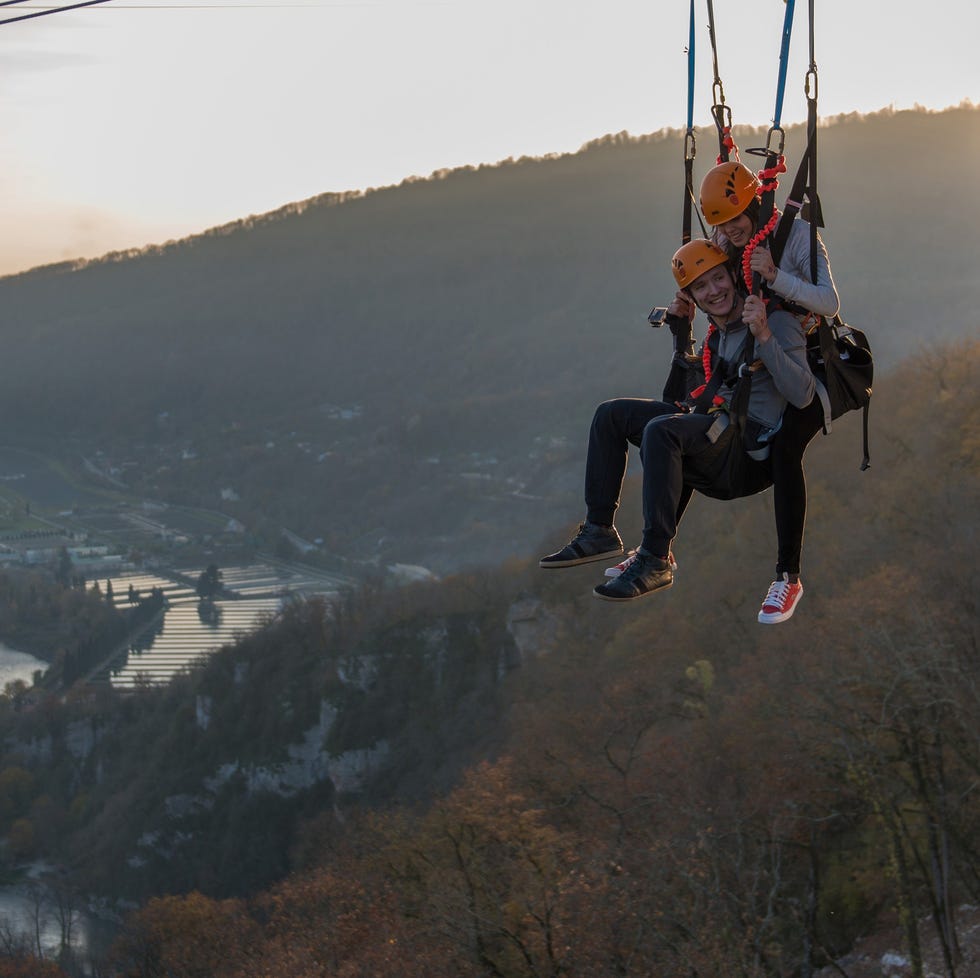
2014: Sochi Swing, Skypark AJ Hackett Sochi, Sochi, Russia
Imagine a beautiful canyon view. It's breathtaking. It's Instagram-worthy. But it's just not heart-attack-inducing. The swing at Skypark Sochi fixes that. It starts at a dizzying height of 558 feet, then plunges riders down and across a 1,640-foot canyon. Oh, and to get there, riders have to cross the longest suspension footbridge in the world.
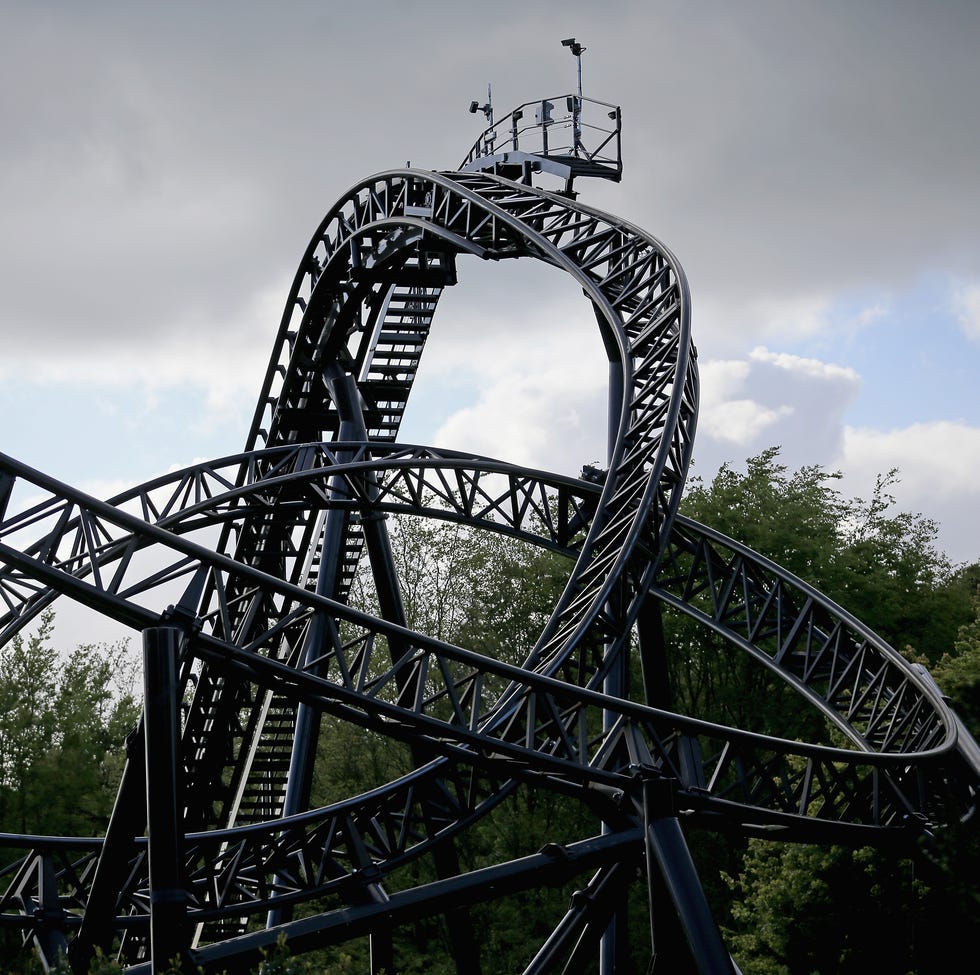
2016: The Smiler, Alton Towers, Staffordshire, UK
We've come a long way since the whiplash-inducing loop-the-loops. Now, on the Smiler, riders can do 14 complete inversions without batting an eye. (Well, maybe while batting an eye — it goes fast.) But it's no without its dangers: The Alton Towers ride had a bad crash in 2015 caused major injuries.
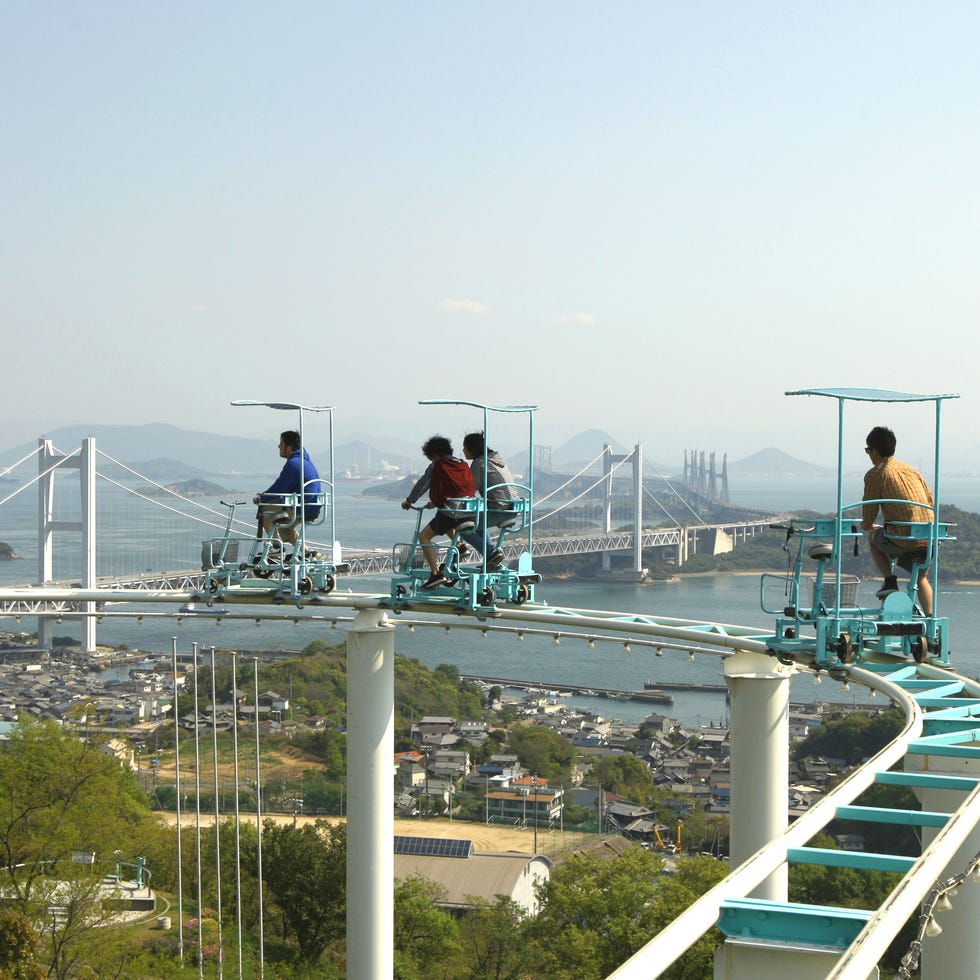
2016: Sky Cycle, Washuzan Highland, Kurashiki-shi, Japan
Theme park operators are constantly coming up with new ways to launch and power their roller coaster cars, but this coaster goes low-tech — it's pedal-powered. Riders travel at their own pace while four stories off the ground, and they can even stop and take pictures if they feel like it.
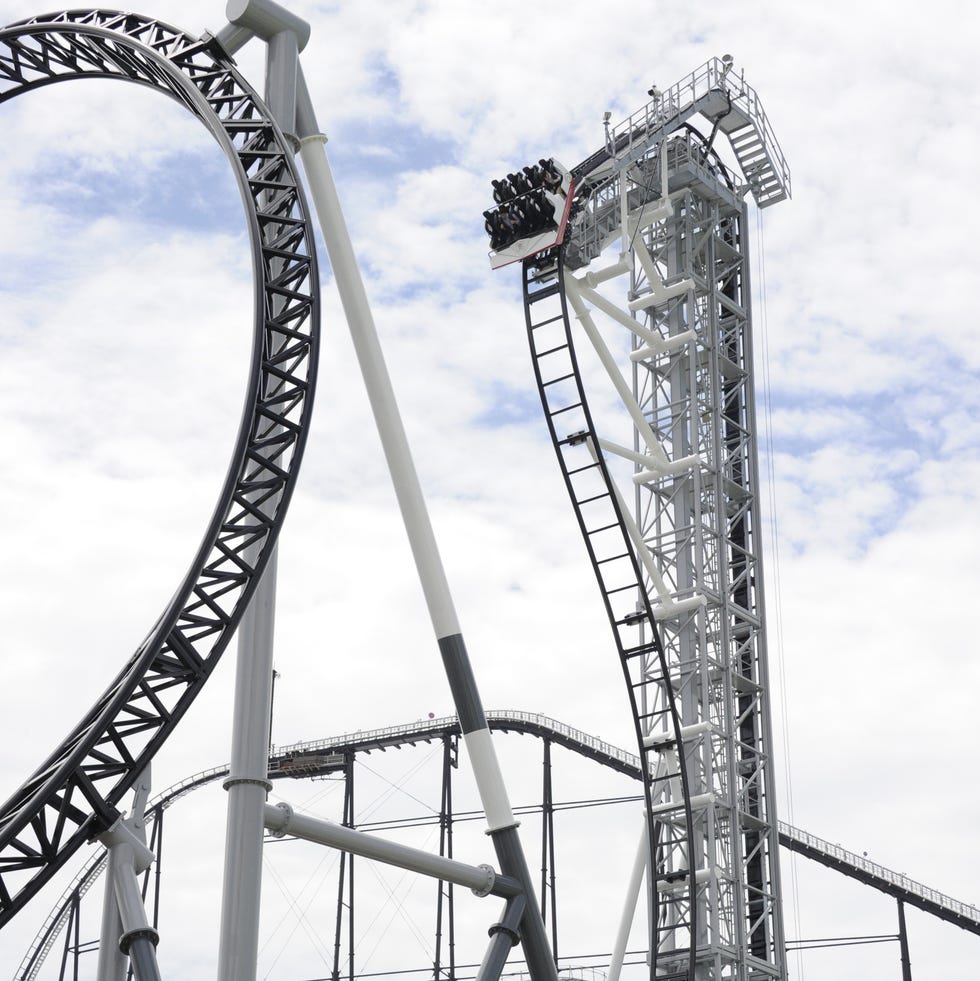
2019: Takabisha, Fuji-Q Highland, Yamanashi, Japan,
You'd think that a 90-degree angle is the steepest possible drop for a roller coaster — but you'd be wrong. This Japanese coaster drops at a hair-raising angle of 121 degrees — yikes! And it's not going to hold onto its record for much longer: The TMNT Shellraiser roller coaster will beat it by just .5 degrees when it opens at American Dreamland's Nickelodeon Universe in New Jersey.

No comments:
Post a Comment